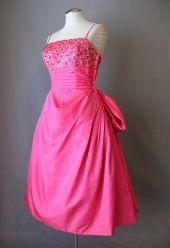

If you've ever purchased a vintage dress and wondered why it doesn't fit correctly, maybe you're not wearing the proper foundation garments. Prior to the late 1960's, clothing was styled and cut with the understanding that women would be wearing girdles and shapers underneath. In the October 1958 Seventeen magazine, there is a wonderful editorial spread photographed by Frencesco Scavullo that illustrates what type of foundation garments work best with several dress styles. I'll be featuring the photos and information from this spread this week.
The magazine is referring to these as "shaft dresses" (never heard that term before). "Newest shape for a shaft to take - the high-rise Empire waist, which looks prettiest over a softly rounded bosom, asks just supple control from there down."
The red dress is by Lanz in a lined rayon crepe. See that band across the bust? The magazine calls this a "bosom yoke" and it drops to a V-neck with a bow in the back. The dress was about $40 (about $298 today), and was sold at Bonwit Teller, New York, Vandervoort's, St. Louis, and The Crescent, Spokane. The model is wearing red DeLiso Debs shoes.
Under the red dress, the model is wearing a Formfit nylon bra with circle-stitched lace cups and a Formfit nylon elastic net panty girdle with a wide waistband and satin elastic vertical stretch panels front and back.
The model on the right in the top photo is wearing a blue wool jersey "shaft dress" by Jerry Greenwald. The front is gathered into a satin band at the Empire waist. In back, the dress is slit from V necline to hem, revealing a satin underslip. This dress also sold for about $40 and was available at Saks Fifth Avenue. That's a long, skinny brooch by Castlecliff pinned to the center of the satin band and the shoes are by Capezio.
Under the blue dress, the model is wearing a Lovable "lightweight all-in-one for a long, slim line with easy control." Made of Helance nylon yarn with embroidered cotton broadcloth cups. This appears to be an open-bottom style.















